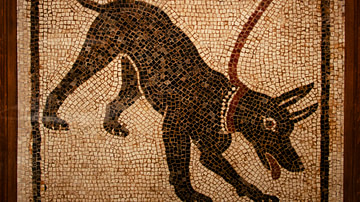As the sun set over the grandeur of ancient Rome, a civilization known for its opulence and extravagance, one could not help but be captivated by the sight of dogs adorned with exquisite collars. These loyal companions, cherished by both emperors and commoners alike, were not only revered for their loyalty and protective instincts but also celebrated as symbols of status and wealth.
A Symbolic Display of Prestige
In ancient Roman society, where social hierarchy was paramount, owning a dog was considered a mark of distinction. However, it was not merely enough to possess these faithful creatures; they had to be presented in a manner that reflected the owner’s elevated standing. Thus emerged an era when dogs’ collars became more than just functional accessories – they transformed into elaborate works of art.
These ornate collars served as tangible representations of their owners’ affluence and taste. Crafted from precious metals such as gold or silver, often encrusted with gemstones like rubies or emeralds, these lavish adornments showcased the wealth and refinement associated with those who possessed them.
Beyond their material value, these extravagant neckpieces carried deep symbolic meaning within Roman culture. They symbolized power, authority, and even divine protection – attributes highly sought after by individuals aspiring to climb the social ladder.
An Expression of Loyalty
The relationship between Romans and their canine companions extended far beyond mere symbolism; it encompassed unwavering loyalty on both ends. Dogs were regarded as steadfast protectors against intruders or potential threats to their owners’ safety.
By adorning dogs with intricately designed collars embellished with intricate patterns inspired by mythology or nature, Romans sought to honor their loyal companions. These collars were not only a testament to the bond shared between humans and dogs but also an expression of gratitude for their unwavering devotion.
Moreover, these lavish collars served as a means of identification, allowing individuals to distinguish their beloved pets from others in crowded public spaces or during hunting expeditions. They became a visual representation of the unique connection forged between man and dog.
A Legacy Preserved
The legacy of dogs’ ornate collars in ancient Rome lives on through archaeological discoveries and artistic depictions that have withstood the test of time. These artifacts provide us with glimpses into a society where even animals were adorned with opulence and revered as symbols of prestige.
Today, we can marvel at these remnants from antiquity – intricate collars that once graced the necks of faithful canine companions. They serve as reminders not only of our enduring fascination with dogs but also our innate desire to elevate them beyond mere pets – transforming them into cherished members of our families and reflections of our own aspirations.
In Conclusion
The grandeur and sophistication associated with ancient Rome extended even to its four-legged inhabitants. The ornate collars worn by dogs in this illustrious civilization represented more than just fashion; they embodied power, status, loyalty, and reverence for the bond between humans and animals. As we look back upon this era through historical records and archaeological findings, we are reminded that throughout history, humanity’s love for its furry companions knows no bounds.

